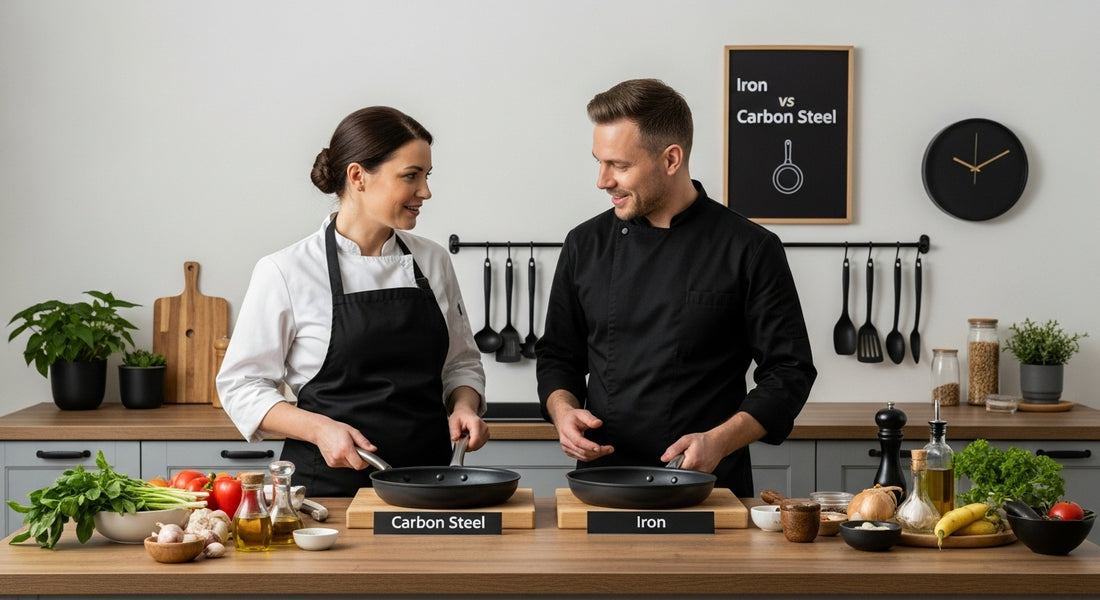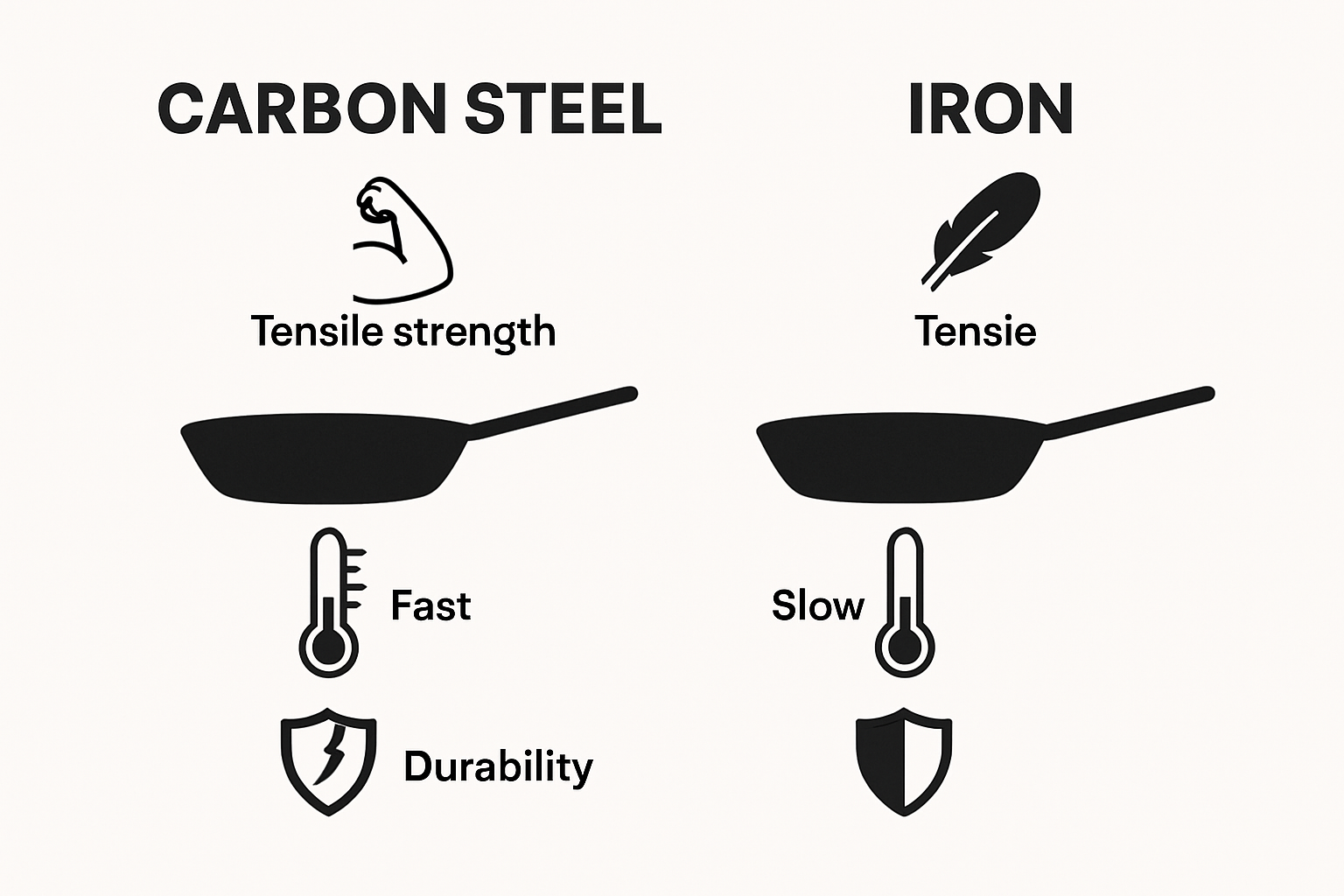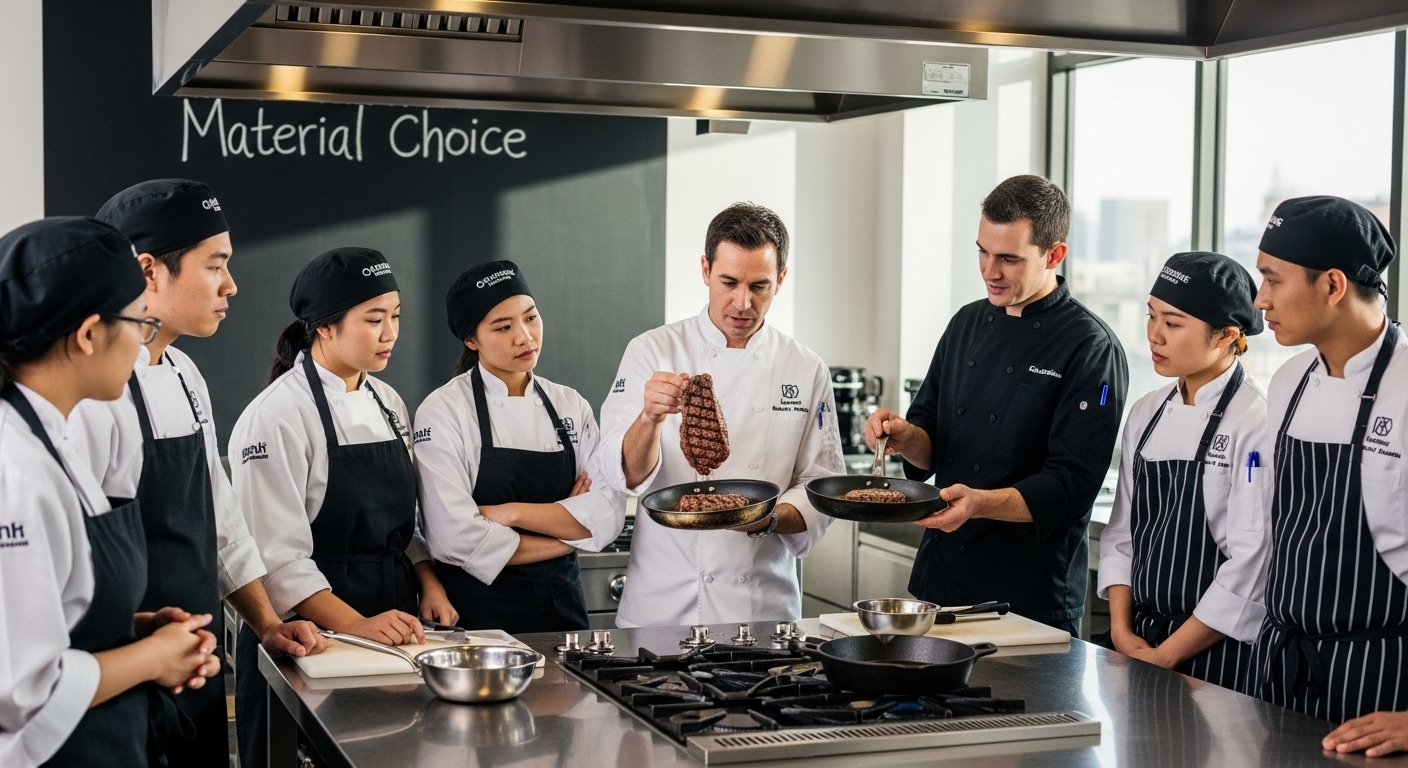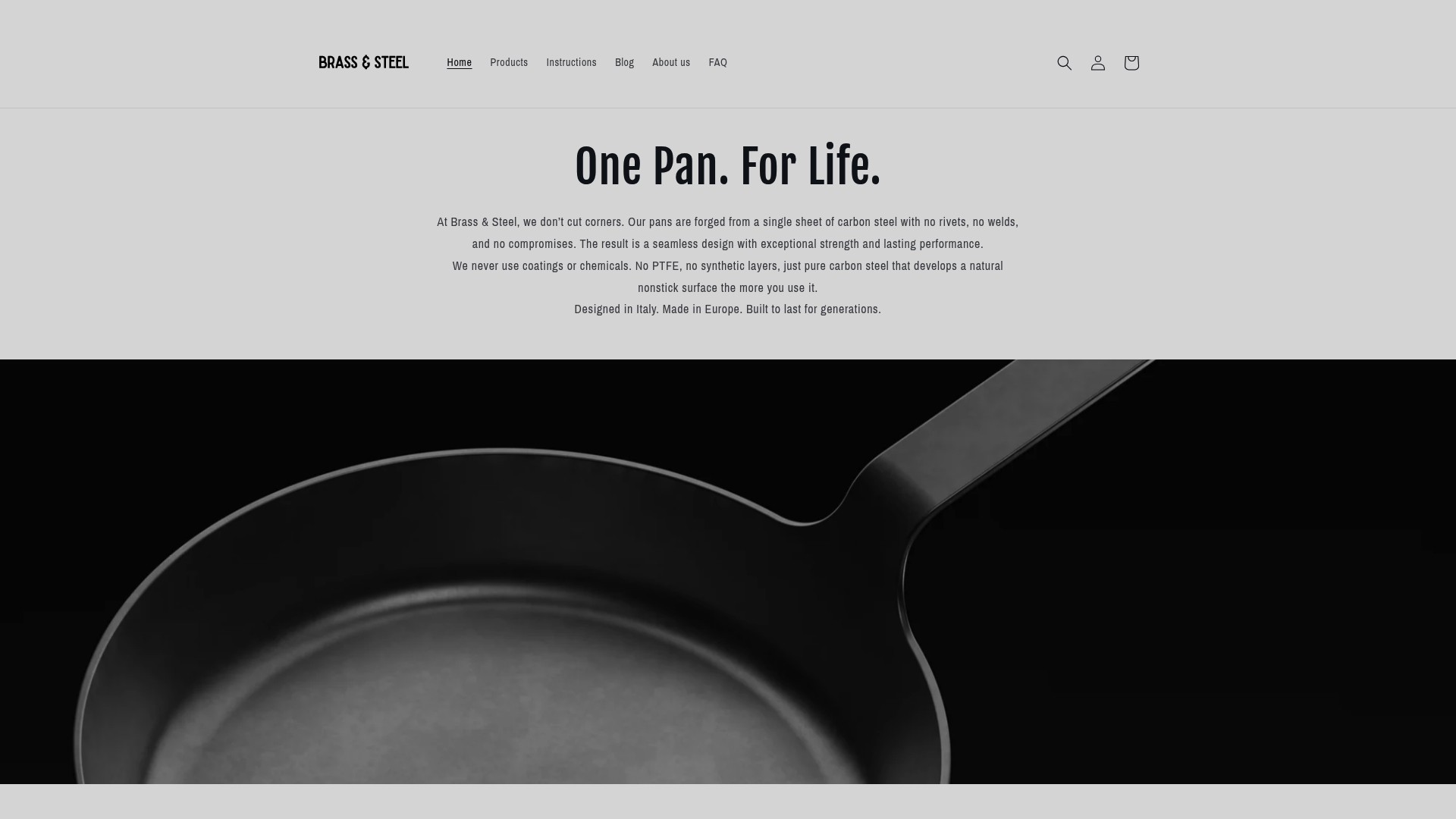
Understanding Iron vs Carbon Steel for Culinary Use
Share
Steel begins as nothing more than soft, workable iron. Yet a subtle shift makes a huge difference. Add just a pinch of carbon and you change everything. Carbon steel gets up to ten times stronger than pure iron, simply by tweaking its carbon content. That might sound like a straightforward upgrade but what really surprises most people is how this tiny change transforms ordinary kitchen pans into professional culinary tools with a unique character of their own.
Table of Contents
- The Nature of Iron and Carbon Steel: Fundamentals Explained
- Why Material Choice Matters in Cooking: Iron vs Carbon Steel
- The Unique Properties of Iron and Carbon Steel: A Comparison
- Practical Applications: Choosing the Right Material for Cooking
- Common Misconceptions about Iron and Carbon Steel in Culinary Context
Quick Summary
| Takeaway | Explanation |
|---|---|
| Carbon addition enhances iron significantly | Adding carbon transforms soft iron into strong carbon steel, improving strength, durability, and performance. |
| Material choice affects cooking quality | Selecting between iron and carbon steel impacts heat distribution, response time, and food quality during cooking. |
| Carbon steel is more durable than perceived | Contrary to popular myths, modern carbon steel cookware is robust, offers resilience and withstands high temperatures effectively. |
| Proper maintenance boosts cookware performance | Gentle cleaning and seasoning increase the longevity and efficiency of carbon steel cookware, contrary to common misconceptions. |
| Carbon steel excels in versatile cooking techniques | Its thermal properties make carbon steel suitable for various methods, from searing to delicate sauces, ensuring professional results. |
The Nature of Iron and Carbon Steel: Fundamentals Explained
Steel represents a remarkable metallurgical achievement that transforms pure iron into a versatile material with extraordinary properties. At its core, steel is an alloy primarily composed of iron and carbon, where the carbon content fundamentally alters the metal’s structural characteristics and performance.
Molecular Structure and Composition
Pure iron exists as a relatively soft and malleable metal with limited practical applications. The introduction of carbon changes this dramatically. When carbon is added to iron during the manufacturing process, typically between 0.2% and 2.1% by weight, it creates interstitial atoms that modify the iron’s crystalline structure. These carbon atoms nestle between iron’s molecular lattice, creating significant improvements in mechanical strength and durability.
our comprehensive guide on carbon steel cookware reveals the fascinating transformation that occurs during this alloying process. The carbon atoms interrupt the iron’s natural slip planes, making the resulting material more resistant to deformation and significantly stronger than pure iron.
Performance Characteristics
The carbon content determines the steel’s fundamental properties. Low carbon steels (below 0.3%) remain relatively soft and ductile, making them suitable for applications requiring flexibility. Medium carbon steels (0.3% to 0.6%) offer an optimal balance between strength and workability, which makes them ideal for culinary tools and cookware.
Key performance characteristics include:
- Enhanced hardness compared to pure iron
- Improved tensile strength
- Greater resistance to wear and mechanical stress
- Superior heat distribution and retention
Understanding these fundamental differences allows chefs and cooking enthusiasts to make informed decisions about selecting the right cooking surfaces.
To clarify the core differences between iron and carbon steel in culinary applications, the table below compares their key properties and how these impact performance in the kitchen.
| Property | Pure Iron | Carbon Steel |
|---|---|---|
| Molecular Structure | Uniform crystalline; low resistance | Carbon atoms interrupt lattice, increasing strength |
| Strength | Relatively soft, malleable | Up to ten times stronger; more resistant to deformation |
| Heat Conductivity | Poor; slow to respond to heat changes | Superior; rapid, even heat distribution |
| Durability | Prone to wear, less robust | Highly durable, withstands high temperatures |
| Nonstick Potential | Lacks natural nonstick | Develops nonstick surface with seasoning |
| Maintenance | Susceptible to rust, less seasoning benefit | Benefits greatly from seasoning; robust with proper care |
| Culinary Versatility | Limited; best for slower cooking | Excels at searing, sautéing, versatile cooking styles |
According to scientific research from Britannica, the controlled addition of carbon creates a material that bridges the gap between pure metallurgical potential and practical culinary performance, making carbon steel an exceptional choice for cooking equipment.
Why Material Choice Matters in Cooking: Iron vs Carbon Steel
The choice of cookware material is not merely an aesthetic decision but a critical factor that directly influences cooking performance, food quality, and overall culinary experience. Understanding the nuanced differences between iron and carbon steel reveals why professional chefs and home cooks carefully select their cooking surfaces.
Thermal Conductivity and Heat Management
Material composition dramatically affects how heat is absorbed, distributed, and maintained during cooking. Pure iron demonstrates poor heat conductivity, making it less responsive to temperature changes. Carbon steel, by contrast, offers superior thermal performance. Its unique molecular structure allows for rapid and even heat distribution, enabling precise temperature control crucial for techniques like searing, sautéing, and creating delicate culinary preparations.
learn more about choosing the right cookware material and understand how these fundamental properties impact your cooking results.
Durability and Performance Characteristics
Carbon steel’s performance extends beyond thermal properties. Its molecular composition provides exceptional strength and resistance to wear. Key advantages include:
- Higher tensile strength compared to pure iron
- Enhanced durability for prolonged kitchen use
- Resistance to warping and deformation
- Ability to develop a natural nonstick seasoning over time
According to comprehensive research from America’s Test Kitchen, carbon steel offers a remarkable balance between the traditional robustness of cast iron and the modern requirements of responsive, versatile cookware.
The material’s inherent properties mean carbon steel pans can withstand high temperatures, rapid temperature changes, and intense cooking techniques while maintaining structural integrity.
This makes them an exceptional choice for professional kitchens and passionate home cooks seeking reliable, high-performance cookware that combines traditional craftsmanship with modern engineering principles.
The Unique Properties of Iron and Carbon Steel: A Comparison
The transformation of pure iron into carbon steel represents a remarkable metallurgical achievement that fundamentally changes the material’s mechanical and thermal characteristics. Understanding these intrinsic differences provides insights into why carbon steel has become a preferred material in professional kitchens worldwide.
Molecular Structure and Performance
At the atomic level, pure iron consists of a relatively uniform crystalline structure with minimal resistance to deformation. The strategic introduction of carbon atoms disrupts this uniformity, creating a complex interstitial arrangement that significantly enhances mechanical properties. Carbon atoms nestle between iron’s molecular lattice, creating pinning points that restrict atomic movement and increase the material’s overall strength.
explore the differences between carbon steel and cast iron cookware to understand how these microscopic changes translate into tangible cooking performance.
Critical Performance Characteristics
The incorporation of carbon fundamentally transforms iron’s inherent properties. Key comparative characteristics include:
- Tensile Strength: Carbon steel demonstrates significantly higher tensile strength compared to pure iron
- Hardness: Enhanced molecular structure provides superior resistance to wear and deformation
- Thermal Conductivity: Improved heat distribution and more responsive temperature management
- Ductility: Maintains workability while increasing overall material resilience
According to scientific research from Physical Review Materials, the precise control of carbon content allows metallurgists to engineer materials with extraordinary performance characteristics tailored to specific applications.
Beyond mere numbers, these properties translate into practical advantages for culinary professionals. Carbon steel’s unique molecular architecture enables rapid and uniform heat distribution, precise temperature control, and remarkable durability.
 This makes it an exceptional material for cookware that demands consistent performance under varying cooking conditions.
This makes it an exceptional material for cookware that demands consistent performance under varying cooking conditions.
Practical Applications: Choosing the Right Material for Cooking
Selecting the appropriate cooking material transcends aesthetic preferences. It represents a strategic decision that directly impacts culinary performance, food quality, and overall cooking experience. Professional chefs and passionate home cooks understand that different cooking techniques demand specific material characteristics.
Thermal Performance and Cooking Techniques
Carbon steel demonstrates exceptional versatility across various cooking methods. Its unique thermal properties enable rapid heat distribution and precise temperature control, making it ideal for techniques requiring immediate responsiveness. Searing meats, creating delicate pan sauces, and executing quick stir fries become significantly more manageable with carbon steel’s superior heat management.
explore advanced cookware comparison techniques to understand the nuanced differences between cooking materials.
Material Selection Considerations
Choosing between iron and carbon steel involves evaluating specific cooking requirements. Critical factors include:
- Heat Responsiveness: Carbon steel offers faster temperature adjustments compared to traditional iron
- Durability: Enhanced molecular structure provides superior resistance to wear
- Maintenance: Carbon steel develops a natural nonstick surface through seasoning
- Versatility: Suitable for stovetop, oven, and open flame cooking techniques
According to culinary research from the eGullet Culinary Institute, carbon steel cookware represents a sophisticated compromise between traditional cast iron and modern cooking requirements. Its medium gauge construction balances heating efficiency with long term durability, making it an exceptional choice for discerning cooks seeking professional grade performance.
The material’s inherent characteristics translate directly into culinary advantages.
 Carbon steel’s ability to develop a natural seasoning, combined with its rapid heat distribution, enables cooks to achieve restaurant quality results with consistent, predictable performance across diverse cooking techniques.
Carbon steel’s ability to develop a natural seasoning, combined with its rapid heat distribution, enables cooks to achieve restaurant quality results with consistent, predictable performance across diverse cooking techniques.
Common Misconceptions about Iron and Carbon Steel in Culinary Context
In the culinary world, myths and misconceptions about cookware materials can significantly influence cooking practices and equipment choices. Understanding the truth behind these widely held beliefs is crucial for making informed decisions about kitchen tools and techniques.
Cleaning and Maintenance Myths
One of the most persistent myths surrounding iron and carbon steel cookware involves cleaning practices. Many home cooks believe that these materials are exceptionally fragile and require extraordinarily complex maintenance. In reality, modern carbon steel cookware is far more robust and adaptable than traditional narratives suggest. Contrary to popular belief, gentle washing with mild soap will not destroy the pan’s seasoning, and proper care actually enhances the cookware’s performance over time.
discover the essential health and safety guidelines for carbon steel cookware to understand proper maintenance techniques.
Performance and Versatility Misconceptions
Several widespread misconceptions exist about the practical capabilities of iron and carbon steel cookware. Key misunderstandings include:
- Nonstick Capability: Carbon steel develops a natural nonstick surface through seasoning, contrary to beliefs about poor food release
- Heat Responsiveness: These materials offer superior heat distribution and control, not the sluggish performance many assume
- Durability: Carbon steel is significantly more resilient and long lasting than frequently portrayed
- Cooking Limitations: Suitable for virtually all cooking techniques, from delicate sauces to high temperature searing
According to research from Virginia Tech food science experts, many traditional assumptions about cookware materials are outdated and fail to reflect modern manufacturing and metallurgical advancements. Contemporary carbon steel cookware represents a sophisticated compromise between traditional craftsmanship and cutting edge material engineering.
Understanding these nuanced characteristics allows cooks to appreciate carbon steel as a versatile, high performance material that offers exceptional culinary potential when used with proper knowledge and technique.
This table outlines common misconceptions versus the actual realities regarding iron and carbon steel cookware, helping to dispel myths and foster correct kitchen practices.
| Myth | Reality |
|---|---|
| Seasoning is easily ruined by gentle washing | Mild washing does not destroy seasoning; proper care enhances it |
| Carbon steel is fragile and short-lived | Modern carbon steel is robust and long-lasting |
| Poor nonstick performance | Seasoned carbon steel develops an effective natural nonstick surface |
| Only suitable for specific cooking techniques | Carbon steel is versatile and suitable for most cooking methods |
| Heat response is sluggish | Carbon steel offers responsive and even heat control |
| High maintenance effort is required | Properly maintained, carbon steel is straightforward to care for |
| Prone to warping under high heat | Carbon steel resists warping and deformation, even at high temperatures |
Elevate Your Culinary Results with Precision-Engineered Carbon Steel
If you have ever wondered why your kitchen creations fall short of restaurant quality, you are not alone. The difference often comes down to your cookware’s material. The article you have just read highlights how carbon steel dramatically outperforms pure iron in heat distribution, strength, and everyday versatility. Many cooks struggle with uneven searing, slow pan responsiveness, and sticky residues. There is no need to settle for less when you can choose a pan that adapts to your ambitions. Explore the Carbon Steel Collection and discover why top chefs and home enthusiasts choose this upgraded material for reliable results and lifelong performance.

Ready for effortless cooking and professional results every night? Experience forged one-piece durability, natural nonstick properties, and perfect compatibility with every hob. Visit https://brass-steel.com today and make the switch to cookware that truly unleashes your culinary vision. Your next heirloom-quality carbon steel pan awaits. Do not let another meal be held back by the wrong tools.
Frequently Asked Questions
What is the main difference between iron and carbon steel in cooking?
The primary difference lies in their composition; carbon steel is an alloy of iron with added carbon, enhancing its strength, heat distribution, and durability compared to pure iron.
How does the carbon content affect the performance of steel cookware?
The carbon content in steel varies from low (below 0.3%) to high (up to 2.1%), which influences hardness, ductility, and heat responsiveness. Higher carbon content typically results in enhanced strength and wear resistance.
Can carbon steel cookware develop a nonstick surface?
Yes, carbon steel cookware can develop a natural nonstick surface through seasoning, which improves its food release properties over time.
How should I maintain my carbon steel cookware to ensure longevity?
To maintain carbon steel cookware, clean it gently with mild soap and avoid harsh scouring. Regular seasoning will enhance its nonstick qualities and protect it from rusting.
Recommended
- Carbon Steel vs Stainless Steel Pans, which one is best? – Brass & Steel
- Is a Carbon Steel Pan the Right Choice for You? – Brass & Steel
- Carbon Steel or Enameled Cast Iron? – Brass & Steel
- How to Choose Between Carbon Steel and Cast Iron Pans for Your Kitchen – Brass & Steel